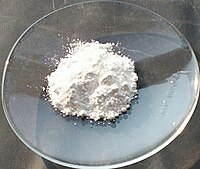
Photo from wikipedia
The optical properties of indium phosphide (InP) quantum dots (QDs) are significantly influenced by their surface native oxides, which are generally removed by treating InP cores with hydrofluoric acid (HF).… Click to show full abstract
The optical properties of indium phosphide (InP) quantum dots (QDs) are significantly influenced by their surface native oxides, which are generally removed by treating InP cores with hydrofluoric acid (HF). Besides the harmful health effects of HF, its etching may cause over-etching or QD size broadening, and surface oxidation can also reoccur rapidly. In the present study, a safer bifunctional metal oleate treatment was developed to simultaneously remove the surface oxide layer and passivate the surface defects for aminophosphine-based InP QDs. Compared to conventional HF etching, the bifunctional metal oleate was able to more efficiently remove the surface oxide of InP cores and effectively preserve the oxide-free surface, leading to a 20% narrower photoluminescence (PL) bandwidth after growing a ZnSe/ZnS shell. The metal oleate treatment is thus considered a greener and safer post-synthetic method to remove InP surface oxide and provide additional passivation to improve the optical properties of aminophosphine-based InP QDs, which could have potential in industrial mass production.
Journal Title: Nanomaterials
Year Published: 2022
Link to full text (if available)
Share on Social Media: Sign Up to like & get
recommendations!